- This article is about the architecture, design and sculptures of the best temples in Khajuraho namely Lakshmana and Kandariya Mahadev. Numerous pictures explain the temple design.
Khajuraho is a small town located in the Bundelkhand region of Madhya Pradesh in Central India which boasts of a rich legacy of Medieval Era Temples that represent a perfect blend of architecture and sculpture which is a composite of Tantric and Puranic elements.
Khajuraho
was once the capital of the Chandel Kings, the descendants of the Moon
God, who patronized artists, poets and performers and built numerous temples. It
is worth knowing that for these architectural wonders, the stone sculptures
were carved and brought from Panna (about 25 kms away), assembled without any
mortar or pasting, but with hinges fixed in between the holes with metal wires,
which are still intact and without any corrosion.
Eighty-five
temples were built in the Nagara Style of architecture out of which only
25 have survived the ravages of time and nature. Most of the temples are made
of sandstone except a few that are made of granite.
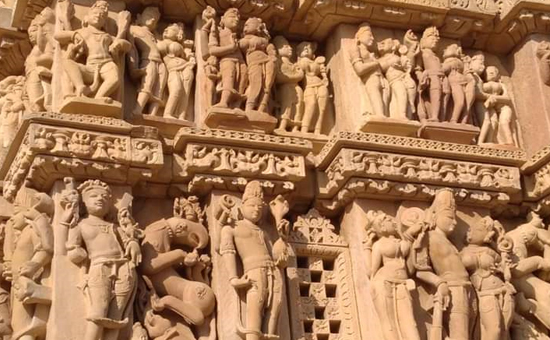 Intricate sculptured walls.
Intricate sculptured walls.
Sculpture
is an art of visual expression, impression and feeling that is best
communicated in the temples of Khajuraho. They portray dynamism in static
stones and movement in immovable spaces which is a unique feature of this
divine establishment...
Known for their artistic creativity, magnificent architectural works, spiritual and erotic sculptures, it's believed that the temples in Khajuraho derive their peace through eroticism, which is in fact a misconception. Actually, erotic sculptures constitute only 10% of the
sculptures in the entire complex. Further, they have
a metaphysical significance of connecting the physical being to the supreme
energy source, which is indeed a journey from the real to the surreal!
Khajuraho
temples celebrate life with all its realm including the four goals of Dharma,
Artha, Kama, Moksh. Dharma is duty towards all, Arth is taking care of the
financial aspects, Kama or Kamana contributes to the beautiful act of
lovemaking i.e. a union of two souls and the source of procreation whilst Moksha
is self-realization or becoming one with the ultimate reality.
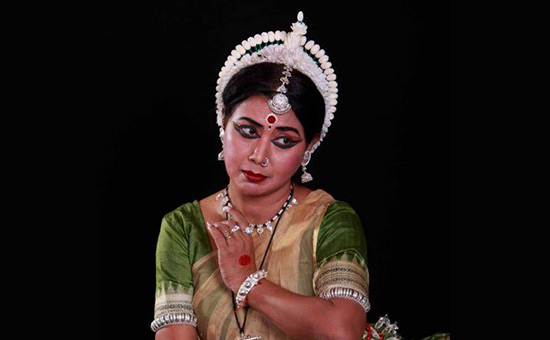 Aruna Mohanty.
Aruna Mohanty.
Odissi Exponent Aruna Mohanty explains these erotic sculptures beautifully. She says, “One cannot look at them from a purely erotic sense, or either from a spiritual angle, or just because of its beauty, we cannot isolate these pieces of art and need to look at them coherently. When you see the beautiful curves of the body, they are again not only erotic but also very divine because it is God's most beautiful creation. When they strike a pose they become someone's Nayika, someone's beloved, mother or someone's sister Jaya, Janani, Bhagini. That is the very philosophy behind these erotic sculptures, which portray life."
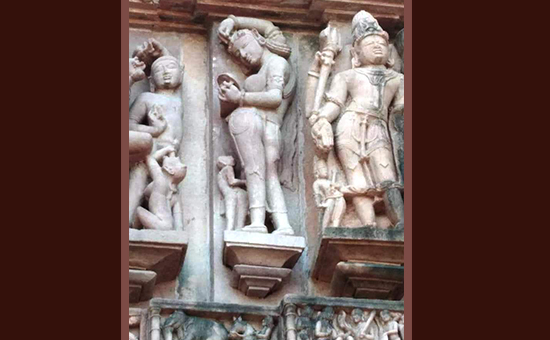 Beautiful Sura Sundaris & Apsaras.
Beautiful Sura Sundaris & Apsaras.
Behind the erotic sculptures of Khajuraho temples is a story which says that the Moon God seduced and made love to a beautiful girl Hemwati. Soon she gave birth to Chandravarman who was the founder of the Chandel Dynasty. As Chandravarman grew, his mother came to his dream and requested him to make a temple that revealed all aspects of passion and erotic fantasy in the world. The story is still sung in the village of Khajuraho, which is an opera full of mystery, seduction, tragedy and finally triumph.
These complex of sunshines was built, keeping in mind the East West axis so they face the direct rays of the rising sun, by King Yasovarma between the 9th and 13th centuries. Extending over an area of 13 square kilometres, the temples represent the pinnacle of the Hindu temple architecture in India.
Initially, the region acquired the name 'Jejakabhukti', named after the Chandella Chief Jeju, or Jayashakti, the third in the genealogy of the kingdom.
After the decline of the Chandela Dynasty in the 13th century, the temples in Khajuraho were left under the cover of dense date palm trees for many years. The word Khajuraho is derived from the word 'Khajur' which means dates in Hindi and eventually in the due course of time gave the city its name 'Khajoraho'. The temples were rediscovered in 1838 by a British Engineer Captain T.S.Burt.
The
Khajuraho complex is divided into 3 geographical regions: Western, Eastern and
Southern. Looking at the architecture we find that the temples have 4-5 unified
units namely Mukhmandapa (entrance
porch), followed by a Mandapa
(assembly hall), Mahamandapa (dance hall),
Antarala (vestibule) and Garbhagariha (inner sanctum). Lastly, Ardhmandapa (a porch) with a hanging
embellishment at the entrance called a Torana.
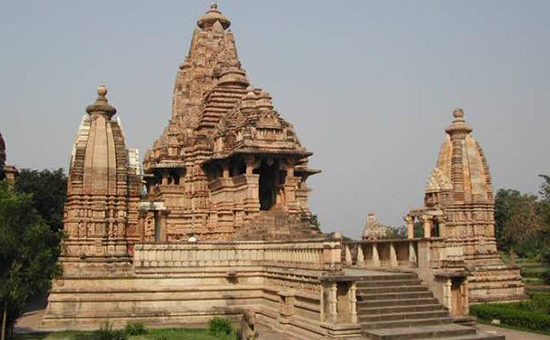 Lakshmana Temple.
Lakshmana Temple.
LAKSHMANA TEMPLE
Lakshmana
Temple happens to be the oldest and the finest of all Khajuraho temples. It was
built in between 930-950 A.D.
The
original patron of the Lakshmana temple was Yashovarman, a leader of the
Chandella clan. He gained control over territories in the Bundelkhand region
that was once part of the Pratihara Dynasty and celebrated his victory by
building the temple. His son Dhanga completed the temple work in 954 C.E.
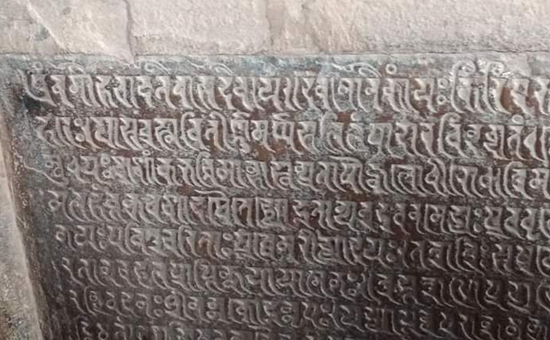 An inscription in Sanskrit describes temple history.
An inscription in Sanskrit describes temple history.
The
Lakshmana Temple is a Sandhara temple of the Panchayatan (five shrined)
variety. It has an entrance-porch, Mandapa, Maha-mandapa, Vestibule, Sanctum
with an Ambulatory along with three transepts that were made of finely grained
sandstone. It is one of the best preserved temples.
This is
the only temple that preserves intact all the subsidiary shrines, the Jagati (platform) with its mouldings
and friezes, and Shikhara (meaning mountain peak). The lowest platform called Adhishthana forms the base on which the
imposing 25.9 metres long Lakshmana Temple stands.
 Gods & Goddesses.
Gods & Goddesses.
A horizontal beam over the entrance of this stunning Vaishnavite temple shows the trinity of Brahma, Vishnu and Shiva with Goddess Lakshmi, Vishnu's consort. The womb chamber, symbolic core of the temple’s shrine, is designed dark and windowless for intimate, individualized worship of the divine, which is quite different from large congregational worshipping spaces. The sanctum enshrines a three-headed and four-armed image of Vishnu as Vaikuntha - Vishnu with a human central head and the side-heads of
boar and lion.
 Ganesha Sculpture.
Ganesha Sculpture.
Devotees
approach the temple for circumambulation called Parikrama starting from the east and walk around its entirety, in a
clockwise direction starting from the left of the stairs of the plinth passing
through images of the temple exterior and finally reaching the Mandapa, to
worship the main deity.
The image
of Lord Ganesha, symbolic of auspicious new beginnings, is placed on the left
niche suggesting that devotees are moving in the correct direction for
circumambulation. The temple has smaller, subsidiary shrines in each corner of
the plinth that appear like miniature temples with their vimanas, shikharas,
mandapas, and womb chambers with images of deities, originally other forms or
avatars of Vishnu.
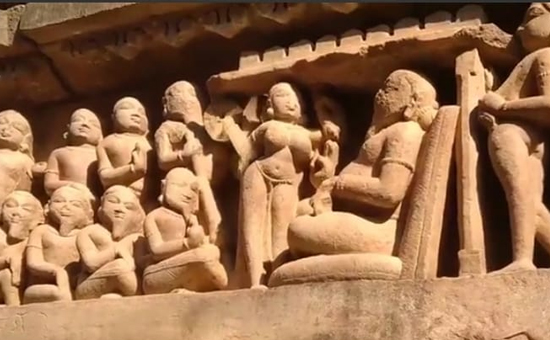 King on a chariot.
King on a chariot.
The well-carved sculpture portrays a king sitting in a chariot being served by female servants. The stone inscriptions describe different types of women to include within a temple’s sculptural program, and emphasizes on their roles as symbols of fertility, growth, and prosperity. There are also stone slabs inscribed with mantras devoted to Lord Shiva.
The King and the Lion Statue is the most common figurine at Khajuraho. It is called Vyala, body of a lion and face of a man, an elephant, goat, parrot
or other animals and birds.
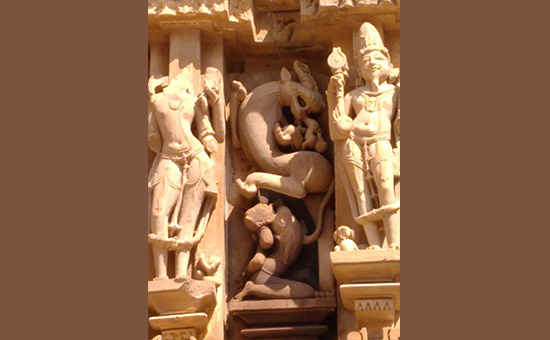 Centre of pic is Vyala.
Centre of pic is Vyala.
The temple's architecture is simply marvellous and its exterior wall exhibits images of over 600 gods. While the sculpted friezes along the plinth also depict images of daily life, love, war and historical events of the Chandella period. A section of a narrative frieze are engraved with exotic battle filled scenes depicting the arms of the era along with elephants and horses as part of the army.
The
Laxmana temple is adorned with beautiful women on its northwest exterior
walls depicting the idealized female power.
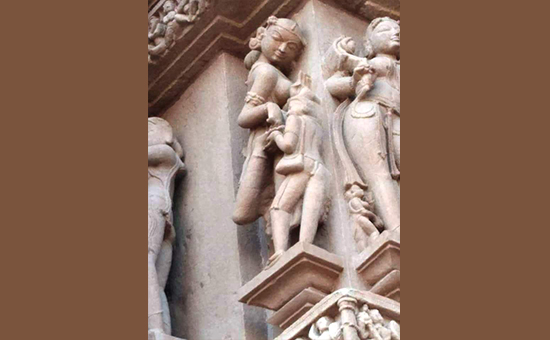 Woman with the Thorn.
Woman with the Thorn.
This iconic sculpture depicts the ideal feminine beauty of an elegant woman who walks barefoot where she steps on a thorn and turns - adeptly bending her left leg, twisting her body, and arching her back - to point out the thorn and ask her attendant’s help in removing it. Note the attendant has a bag round shoulder.
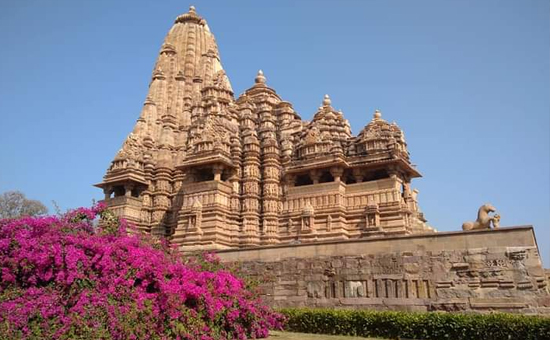 Kandariya Mahadev Temple.
Kandariya Mahadev Temple.
KANDARIYA MAHADEV TEMPLE
The name of this Shiva temple consists of two words Kandara and Mahadeva, which means "the Great God of the Cave". The temple is the largest and most ornate Hindu temples in Khajuraho. It was built during
the reign of King Vidyadhara between c.1025 and 1050 A.D. to commemorate his
victory over the Mahmud of Ghazni.
Evident
from its beautiful Vastu art, the temple is known as the most perfect and
finest of all temples because of its artistic and analytic temple plan and
architecture in terms of its elevation, ceiling, materials used and
extraordinary sculpture content.
The temple measures about 30.5 metres in both length and height and 20 metres in width. The main spire known as the ‘Shikhara’ rises up to 31 metres and is surrounded by 84 miniature spires that appear to be clambering up the central tower that rises skyward depicting Mount Meru, the holy mountain of Shiva. The curve of the shikhara grows narrower as it reaches the pinnacle.
Jagati is
a term used to refer to a raised platform upon which the temple is placed.
Kandariya Mahadeva temple is built on a fairly 3 metre high Jagati which has
two free-standing Sardella statues,
each supporting with a man at each corner. The temple
stands on a basement storey called the Adhishthana
that is erected on a Dharamsala of granite.
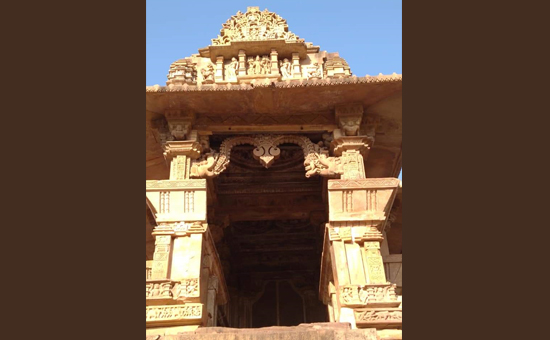 Mukara Toran.
Mukara Toran.
This
temple comprises all essential elements of the Nagara style of architecture
containing all five units of the temple. The entrance porch Mukhmandapa has four pillars with decorated shafts with stencilled scrolls and pot art foliage. The entrance porch is decorated with five looped arches known as the ‘Makara Torana’ wherein the Makara is the mythical aquatic creature that combines the jaws of a crocodile, trunk of an elephant, ears of a lion, horns
of a ram, and the tail of fish, that is considered as the mount of the
river goddess Ganga.
Stemming out of the mouths of ever-watchful mythical crocodile, the finely chiselled torana looks more like carved out of ivory than stone that is designed like a garland of flowers strung across the doorway to make your entrance both auspicious and hallowed. The toran flanks the figures of divine couples Shiva Parvati on the outer faces and of Brahma Brahmani and Lakshmi Narayana on the left and right inner sides respectively.
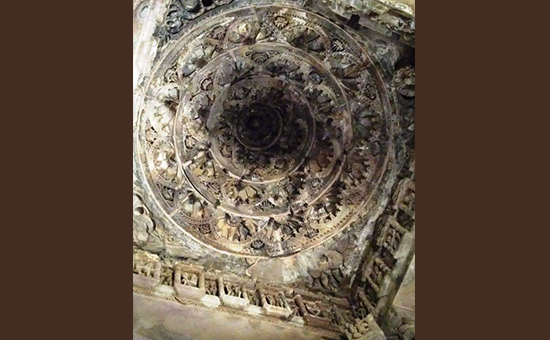 Floral ceiling.
Floral ceiling.
The square ceiling built-in ‘Nabhichchanda’ style is composed of a series of diminishing circles that overlap to form five cusped flowers that are deeper than the remaining. The inner roofs of the assembly hall known as the ‘Mandap’ is worthy of admiration as it is created like great upside-down pools with flower and leaf motifs and Apsaras.
.jpeg) This Erotic sculpture signifies a Yantra.
This Erotic sculpture signifies a Yantra.
According to the architectural book 'Shilpa Prakasha,' it is speculated that the erotic figures were some sort of a code language to convey the Tantric doctrine, wherein each temple has installed some sort of magical yantra to protect it from evil forces. While you visit the Kandariya Mahadev the temple you notice that the erotic postures were pointed in a line symmetry superimposing the yantra which is bang opposite the Chausath Yogini temple, which being a Shakti Peeth was the centre of all Tantric and energy transfer activities in the then era.
The energy
was generated through the activation of the Kundlis (sacral chakra) in the
human body. The idea was that by indulging in the bodily and material worlds, a
practitioner was able to reach and remain in the state of ecstasy, leading to
an ultimate union with the supreme power, thereby transcending all senses. The
erotic images of the temples are ascribed as the Kapalika tantric practices prevalent at Khajuraho during Chandela
rule.
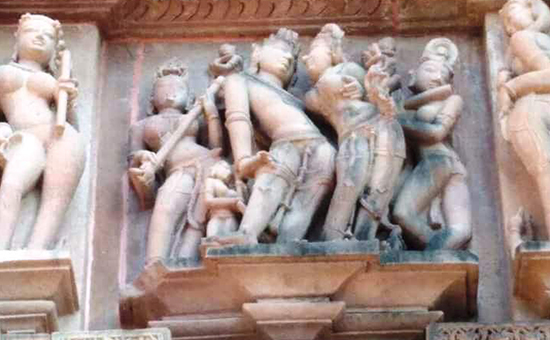 Dancers and Musicians.
Dancers and Musicians.
We get to
learn a lot about the prevalent dance forms and music through these sculptures.
They depict musicians playing the Flute, Tambura and Mridangam while
accompanying dancers perform beautiful Bharatnatyam movements, adorned with
beautiful costumes and jewellery like studded neck pieces, bangles, anklets,
waist bands, headgear and on looking the mirror.
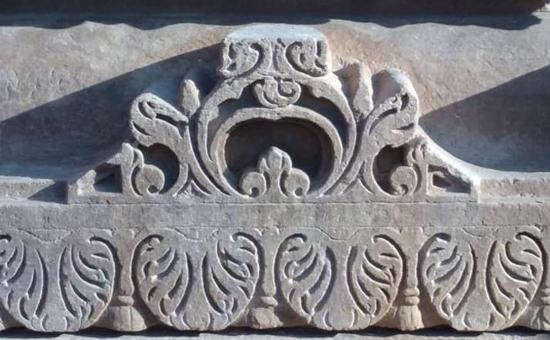 Mouldings.
Mouldings.
The
mouldings of the base story comprises of ornate stencilled scrolls of lotus
petals with circular rosettes. While, below them we find decorated
processional frieze representing horses, elephants, warriors, hunters, dancers,
devotees, acrobats and musicians and miscellaneous scenes.
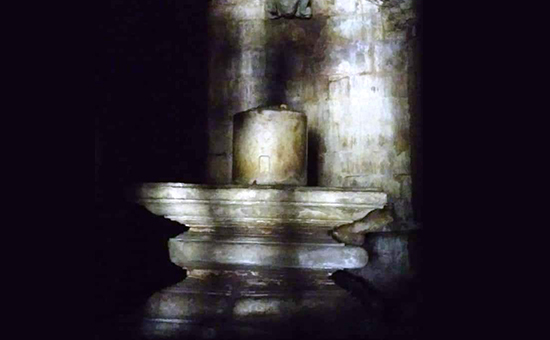 Shivling.
Shivling.
The transitional space between the temple's main hall and the inner sanctum (Garbhagrha) is known as the vestibule or the ‘Antarala’ happens to be a primary site for large panels with sexually explicit scenes that probably indicates that sexuality and encountering the divine are both liminal experiences. Within the dark, unadorned Garbha griha is the innermost chamber of the temple (four feet in circumference) or womb chamber. Here in lies the Shivalinga on a much higher level than the floor of the Garbha-gariha itself. The inside wall of the chamber also carries the seated figure of Shiva holding a trident and snake, while Vishnu is seated to his left and Brahma to the right.
In the Kandariya Mahadeva temple, there are 26 images of Hindu Gods and Goddesses placed in the inner sanctum known as ‘Mahamandapa’ namely seated and standing Uma Maheshvara, Shiva Parvati, eight-armed Brahma, Vishnu, Narasimha, Ardhanarishvara, Shiva, Bhairva, Devi with the lion mount, Indra, Sadashiva to name a few. The darker recesses of the wall surface area inhabited by protective creatures, Vyala, mythical being fighting the forces of evil and Nag kanyas folding their hands in prayer and blessings posture.
 Nag kanya. Also seen in Rani-ki vav Patan, Gujarat.
Nag kanya. Also seen in Rani-ki vav Patan, Gujarat.
The
temple boast of exquisitely carved 99 statues and images of 7 mothers along
with Ganesha, Virbhadra that are intricately carved in the principal niches of
the basal storey along with cult images of Parivara
devatas (Family deities) and 27 sculptures of elephants, hunters and
acrobats.
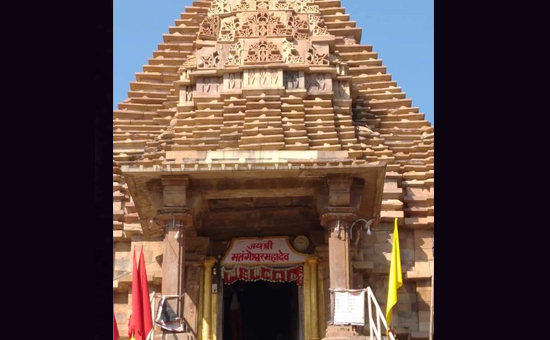 Matangeshwar Mandir.
Matangeshwar Mandir.
It is about
2,000 years old and the oldest temple of Khajuraho where devotees worship the
shivling to this day. The shivling grows 1.5 cm every year and is almost 18
feet tall.
The Devi Jagdamba temple is also open for worship of Devi Jagdamba (Durga) but only during the 'Navratras'. The rest of the temples are regarded as UNESCO world heritage monuments.
The week-long 'Khajuraho Dance Festival’ celebrates the richness and depth of different Indian classical dances styles which complement the architectural richness of the temples in the backdrop.
All pictures by author. To read all articles by author
Also read
1. Khajuraho
Dance Festival 2021
2. Khajuraho
Dance Festival 2021, An Ode to Abhinaya
3. Pics
of Khajuraho Temples Western
4. Khajuraho
Utsav, An Amalgamation of Fine Arts
5. Kandariya
Mahadev Mandir
6. Lakshmana
Temple
7. Deeper
meaning behind erotic sculptures of Khajuraho
8. All
about Khajuraho Temples